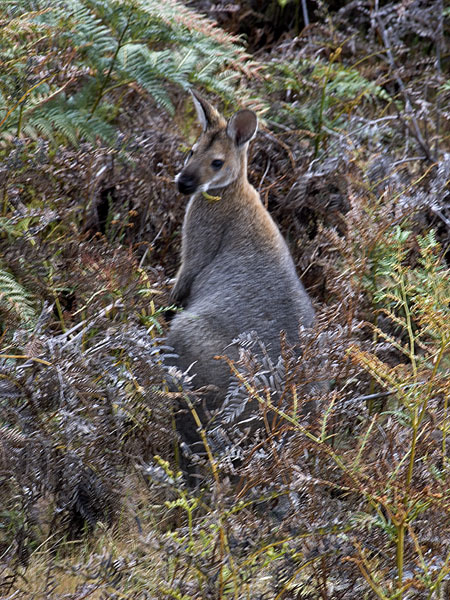 Macropus
rufogriseus
Macropus
rufogriseusRed-Necked Wallaby

 :: Habitat and Geography
:: Habitat and Geography
Where can you find a Red- Necked
Wallaby?

The Red-Necked Wallaby is typically found in the coastal region of eastern and southeastern Australia, most commonly in Queensland. They also found in New South Wales, and on the Islands of the Bass Straight and Tasmania. There is a small colony of Red-necked Wallabies in England that were introduced from Australia in the 1940's. In 1870 two does (females) and one Buck (male) were transported to New Zealand where they populated and currently still inhabit there.

These animals live in Eucalypt forests and other shrub covered areas. The covered areas that they live in are also close to rivers and open areas, where they go to feed. They are nocturnal, so during they day they lay in the coverings, sleeping and shading themselves. Then at dusk or early morning they go into the open clearings to eat.
The Red-necked Wallaby is a solitary animal and usually lives by itself or with it's Joey. Although they are solitary animals they share a common feeding ground with a group. A group of Wallabies is called a Mob and usually consists of about thirty individuals. The female offspring of wallabies stay around their home area of their mother, while the males usually find a new home at about two years of age.
Under good climatic conditions, populations can be extremely dense, and sometimes become a large pest problem. In 1870 when the two does and one buck were introduced in Canterbury, New Zealand the population grew very large. Between 1948-1965 they were controlled by government departments, and over 70,000 were shot, plus thousands more by private hunters.

There are many other organisms that share the habitat of the Red-necked Wallaby. A few of these organisms are their marsupial relatives such as Kangaroo and Koala. Others, just to name a few, included snakes, lizards, emus, and their predators, Dingoes. There is also many varieties of insects and plants.
Find out how they adapted!!!

The Red-Necked Wallaby is typically found in the coastal region of eastern and southeastern Australia, most commonly in Queensland. They also found in New South Wales, and on the Islands of the Bass Straight and Tasmania. There is a small colony of Red-necked Wallabies in England that were introduced from Australia in the 1940's. In 1870 two does (females) and one Buck (male) were transported to New Zealand where they populated and currently still inhabit there.

These animals live in Eucalypt forests and other shrub covered areas. The covered areas that they live in are also close to rivers and open areas, where they go to feed. They are nocturnal, so during they day they lay in the coverings, sleeping and shading themselves. Then at dusk or early morning they go into the open clearings to eat.
The Red-necked Wallaby is a solitary animal and usually lives by itself or with it's Joey. Although they are solitary animals they share a common feeding ground with a group. A group of Wallabies is called a Mob and usually consists of about thirty individuals. The female offspring of wallabies stay around their home area of their mother, while the males usually find a new home at about two years of age.
Under good climatic conditions, populations can be extremely dense, and sometimes become a large pest problem. In 1870 when the two does and one buck were introduced in Canterbury, New Zealand the population grew very large. Between 1948-1965 they were controlled by government departments, and over 70,000 were shot, plus thousands more by private hunters.

There are many other organisms that share the habitat of the Red-necked Wallaby. A few of these organisms are their marsupial relatives such as Kangaroo and Koala. Others, just to name a few, included snakes, lizards, emus, and their predators, Dingoes. There is also many varieties of insects and plants.
Find out how they adapted!!!





